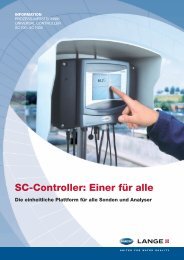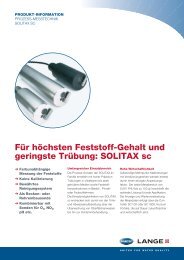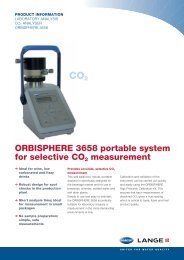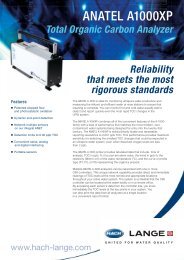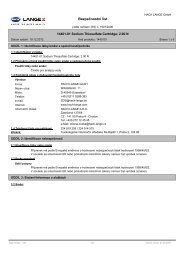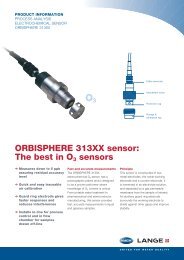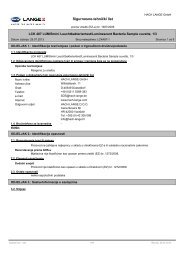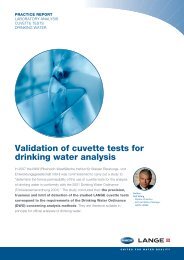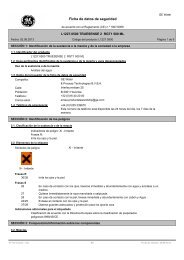Optimal nutrient ratios for wastewater treatment - HACH LANGE
Optimal nutrient ratios for wastewater treatment - HACH LANGE
Optimal nutrient ratios for wastewater treatment - HACH LANGE
Create successful ePaper yourself
Turn your PDF publications into a flip-book with our unique Google optimized e-Paper software.
PRACTICE REPORTLABORATORY & PROCESS ANALYSISWASTEWATER TREATMENTNUTRIENTS<strong>Optimal</strong> <strong>nutrient</strong> <strong>ratios</strong> <strong>for</strong><strong>wastewater</strong> <strong>treatment</strong>To be able to comply with the legal requirements on treated <strong>wastewater</strong>, plantoperators must control the <strong>treatment</strong> process carefully, so that they can intervenepromptly to prevent limit values from being exceeded. Besideschemical and physical methods, <strong>wastewater</strong> <strong>treatment</strong> is essentially basedon biological <strong>treatment</strong> by microorganisms in activated sludge.Knowledge of the <strong>nutrient</strong> requirements and the composition of theactivated sludge are there<strong>for</strong>e needed if the plant is to operate at maximumefficiency. The causes and effects of unfavourable <strong>nutrient</strong> <strong>ratios</strong>, andthe measures to be taken to deal with them, are described in this report.Author:Dipl.-Ing. Michael Winkler- Project Leader, Product Developmentand Customer Service- BIOSERVE GmbH, Mainz
2NUTRIENTS ACTIVATED SLUDGENutrients in activated sludgeLaboratory analysis and processmeasurement technology supportcompliance with the limit values.A balanced <strong>nutrient</strong> ratio is essential ifthe microorganisms are to function atmaximum efficiency. The most importantof these <strong>nutrient</strong>s are carbon, nitrogenand phosphorus.CarbonCarbon is the principal component of theorganic substances found in <strong>wastewater</strong>.It is biodegraded by the microorganismsin activated sludge under anaerobic conditions(bio-P), in an anoxic environment(denitrification zone) and in the aeratedpart of the biological stage (nitrificationzone). The microorganisms use the carboncompounds to build their cell structuresand to generate energy.<strong>wastewater</strong> <strong>treatment</strong>, organic N is convertedto NH 4 -N by the bacteria in theactivated sludge. This NH 4 -N and theNH 4 -N from the inflow are converted tonitrite, which in turn is converted tonitrate (nitrification).The nitrogen compounds that are notbiodegraded in the activated sludge areconverted under anoxic conditions(absence of dissolved O 2 ) to elementarynitrogen (denitrification). This escapesinto the atmosphere as N 2 . Nitrogen compounds are determinedas NH 4 -N, NO 2 -N, NO 3 -N and TN(total nitrogen, which is important <strong>for</strong>balancing and outflow checks).The workplace <strong>for</strong> laboratoryanalysis consists of a photometer,reagents and – depending on theparameter – a thermostat. Carbon compounds are determinedas COD, BOD 5 or TOCNitrogenIn the inflow of <strong>wastewater</strong> <strong>treatment</strong>plants, nitrogen is present in organi callybonded <strong>for</strong>m (organic N) and as ammoniumnitrogen (NH 4 -N). During biologicalOrganic compounds + O 2 + NutrientsPhosphorusThe P load in the inflow of a <strong>wastewater</strong><strong>treatment</strong> plant is made up o<strong>for</strong>thophosphate-phosphorus (PO 4 -P),polyphosphates and organic phosphoruscompounds. Together, they give the sumparameter ‘total phosphorus’ (P tot ).MicroorganismsNew cell material + CO 2 + H 2 OTable 1: Important sum parameters <strong>for</strong> <strong>wastewater</strong> <strong>treatment</strong>COD (Chemical Oxygen Demand); this corresponds approximately to the amount of oxygenrequired to completely oxidise the carbon compounds, including reduced inorganic compounds.BOD 5 (Biological Oxygen Demand); this indicates how much elementary oxygen is consumed duringfive days of biodegradation by microorganisms under standard conditions.TOC (Total Organic Carbon) is a measure of organically bonded carbon; in contrast to BOD 5 , TOCalso includes the carbon in poorly biodegradable compounds.TKN (Kjeldahl nitrogen) is a measure of organically bonded nitrogen (organic N) and ammoniumnitrogen (NH 4 -N).Total nitrogen TN (LATON) includes organically bonded nitrogen, ammonium nitrogen (NH 4 -N),nitrite (NO 2 -N) and nitrate (NO 3 -N).www.hach-lange.com
3NitrificationDenitrificationOrganic N compounds(urea, proteins, etc.)Hydrolysis and ammonificationNitrate-nitrogen NO 3 -NNitrate reductase- OxygenAmmonium-nitrogen NH 4 -N Nitrite-nitrogen NO 2 -NNitrite-nitrogen NO 2 -NNitrate-nitrogen NO 3 -NNitrosomonas+ OxygenNitrobacter+ OxygenNO, N 2 OElementary nitrogen N 2 Nitrite reductase- OxygenNO, N2O reductase- OxygenOxygenOrganic C compoundsCarbon dioxide CO 2 Fig. 1: Degradation processes during nitrification and denitrificationDuring biological <strong>wastewater</strong> <strong>treatment</strong>,polyphosphates and organically bondedphosphorus are converted to orthophosphate.The P demand of the organisms isdue to the special role of phosphorus intheir energy metabolism. P is needed to<strong>for</strong>m the cell membrane and DNA.Some of the phosphorus in <strong>wastewater</strong>is eliminated biologically (bio-P).The rest can be removed by chemicophysicalphosphate precipitation. Phosphorus compounds are determinedas ortho-PO 4 -P (control ofprecipitation) and as P tot (balancing,outflow monitoring)Trace elementsOther trace elements needed to buildcells – e.g. potassium, magnesium,manganese, iron, copper, zinc and nickel,and vitamins and growth factors – areusually present in municipal <strong>wastewater</strong>,or the microorganisms in the activatedsludge provide them themselves.SulphurSeptic domestic <strong>wastewater</strong> and someindustrial <strong>wastewater</strong> contain reducedsulphur compounds (hydrogen sulphide,sulphides and thiosulphates). Sulphur isan indispensable component of proteins.In <strong>wastewater</strong> <strong>treatment</strong> plants, reducedsulphur compounds are not only oxidisedchemically to sulphate but are also oxidisedby some bacteria to <strong>for</strong>m sulphurand, since this process generates energy,are stored inside cells as food reserves.High concentrations of reducedsulphur compounds in <strong>wastewater</strong> can,however, cause a number of problems(Table 2).C:N:P ratio (BOD 5 :TN:P tot )The content of the individual <strong>nutrient</strong>s in<strong>wastewater</strong> should correspond to theneeds of the bacteria in the activatedsludge, and there should be a balancedrelationship between C, N and P. This iscrucial to the effectiveness of the biodegradationprocesses. During aerobic waste -water <strong>treatment</strong>, the C:N:P ratio shouldbe in the range between 100:10:1 and100:5:1.Reagent-free probes are used <strong>for</strong>continuous monitoring.Modern analysers are mounteddirectly on the edge of the tankand do not need a protectivehousing.
4 NUTRIENTS_CALCULATIONFavourable and unfavourable<strong>nutrient</strong> <strong>ratios</strong>SC 1000 controller <strong>for</strong> up to eightsensors – also suitable <strong>for</strong> useas a network with, <strong>for</strong> example,ProfibusHowever, all sorts of industrial plants,regional differences in eating habits (disposalof different kitchen wastes throughthe drains), and the nature of the soil anddrinking water cause <strong>wastewater</strong> to varywidely in its composition. Experience hasshown that the C:N:P ratio in municipal<strong>wastewater</strong> is about 100:20:5.The excess N and P compounds canusually be eliminated from the <strong>wastewater</strong>without any great difficulty usingmodern methods.If the <strong>wastewater</strong> in the inflow to the biologicalstage is deficient in one of themain <strong>nutrient</strong>s, a wide range of problemsmay occur (Table 3).For efficient denitrification, a certainproportion of readily biodegradable Ccompounds must be present. Aftermunicipal <strong>wastewater</strong> has passedthrough the primary settling tank, it has aBOD 5 :N ratio of 100:25 (=5). If the ratiofalls below 100:40 (=2.5), the efficiencyof the denitrification process is impaired,resulting in higher nitrate values in theoutflow. If bypassing the primary <strong>treatment</strong>and increasing the denitrificationvolume fail to bring about any improve-Partially immersed NITRATAX scprobe <strong>for</strong> online nitratemeasurementTable 2: Causes and effects of high sulphur concentrationsCauses/Origin of <strong>wastewater</strong> Possible consequences Corrective action• High concentrations of sulphurcompounds from chemicaland protein processingindustries (meat and poultryprocessing)• Anaerobic processes in thesewerage system, whichcause sulphur compoundsto be reduced to hydrogensulphide• Corrosion in sewers andtank walls in <strong>wastewater</strong><strong>treatment</strong> plants• Neighbours suffer odournuisance• Increased growth ofsulphur oxidising filamentousbacteria (Type 021 N)• Avoid blockages in thesewerage network• Add iron salts to the sewer(e.g. at the pumping stations)Table 3: Causes and effects of <strong>nutrient</strong> deficiencies in the biological stage of <strong>wastewater</strong> <strong>treatment</strong>Shortage of Causes/Origin of the <strong>wastewater</strong> Possible consequences Corrective actionCarbon • Long dwell time in the seweragenetwork• Far-reaching primary <strong>treatment</strong> ofthe <strong>wastewater</strong>• Industrial <strong>wastewater</strong> with a highnitrogen content, e.g. from milk andmeat processing• Profuse development of filamentousbacteria (sludge bulking and foam)• Insufficient denitrificationNitrogenPhosphorusLow-nitrogen <strong>wastewater</strong> from:• Paper industry• Fruit and vegetable processing• Landfill leachate, <strong>wastewater</strong> fromfruit and vegetable processing• High COD/TOC values in the inflowof the <strong>wastewater</strong> <strong>treatment</strong> plant• Filamentous bacteria• Increased COD/TOC values in theoutflow• Filamentous bacteria• Bypass the primary <strong>treatment</strong>• Increase the denitrification volume whileretaining sufficient volume <strong>for</strong> the nitrification(minimum sludge age of 9 days)Balance the <strong>nutrient</strong> ratio by:• Addition of N compounds(good-value industrial products such as urea)• Addition of domestic <strong>wastewater</strong>, turbid waterfrom digesterBalance the <strong>nutrient</strong> ratio by:• Addition of P compounds (good-value industrialproducts such as phosphoric acid or phosphatefertilisers <strong>for</strong> the agricultural sector)• Addition of domestic <strong>wastewater</strong>www.hach-lange.com
5ment, the addition of a readily degradablesubstrate (external source of carbon)should be considered.Carbon sources <strong>for</strong> <strong>nutrient</strong> balancinginclude:- Internal C = hydrolysed or acidified primarysludge- External C = industrial residues (frombreweries, dairies, sugar industry) andindustrial products (methanol, ethanol,acetic acid).COD:BOD 5 ratioThe ratio of these two sum parametersis a measure of the biodegradability ofthe <strong>wastewater</strong> pollution load. If theCOD:BOD 5 ratio does not exceed 2:1,the biodegradability is said to be good.Higher values indicate the presence ofpoorly biodegradable substances.ExampleA municipal <strong>wastewater</strong> <strong>treatment</strong>plant with a high proportion of industrial<strong>wastewater</strong> has the following <strong>nutrient</strong>parameters in the inflow to the biological<strong>treatment</strong> stage (Table 5).The BOD 5 :N ratio of 2.45 is too low <strong>for</strong>adequate denitrification to occur. Externalcarbon compounds should there<strong>for</strong>ebe added. However, a number of calculationshave to be carried out be<strong>for</strong>e thisis done:1. Amount of nitrogen that is notto be denitrified (N n.z.d. ): see Table 62. Calculate the amount of nitrogenthat can be denitrified withthe <strong>wastewater</strong>:With upstream denitrification and aV D :V AT ratio of 0.5, the denitrificationcapacity (according to Table 7) isC Deni = 0.15 kg NO 3 -N D /kg BOD 5 .S NO3-N, D = C Deni × BOD 5 infl aer= 0.15 × 110 mg/L = 16.5 mg/LThe practical <strong>LANGE</strong> cuvette testsare available <strong>for</strong> all key parameters.In combination with analyticalquality assurance, the measurementresults are officiallyapproved.This means that 16.5 mg/L NO 3 -N canbe denitrified with the existing biological<strong>treatment</strong>.Table 4: Causes and effects of unfavourable COD:BOD 5 <strong>ratios</strong>Causes/Origin of <strong>wastewater</strong> Possible consequences Corrective action• Landfill leachate, <strong>wastewater</strong>from composting and residualwaste <strong>treatment</strong> facilities andthe chemical industry• Considerable reduction inBOD 5 in the long sewage networkin summer• Intensive primary <strong>treatment</strong>of the <strong>wastewater</strong>• Inadequate denitrification(high nitrate values in theoutflow)• High COD in the outflow ofthe <strong>wastewater</strong> <strong>treatment</strong>plant• Deterioration of bio-P• Addition of C sources toimprove denitrification• Use chemicophysical methods(ozone <strong>treatment</strong>, activatedcarbon filter, membrane technology)<strong>for</strong> poorly biodegradableand non-biodegradablesubstancesIf large numbers of samples haveto be analysed, the automaticlaboratory analysers offer valuablesupport.
6 NUTRIENTS_CONTROLRegulating the substrate dosage bymeans of NO 3 -N measurementsTable 5: Average daily values of a municipal <strong>wastewater</strong> <strong>treatment</strong> plantAverage daily valuesInflow [m 3 /d] 10,000BOD 5 infl aer [mg/L] 110TN infl aer LATON [mg/L] 45P tot infl aer [mg/L] 3,5BOD 5 infl aer. : TN infl aer = 110:45 = 2.45Table 6: Calculation of amount of nitrogen that is not to be denitrified (ΣN n.d. )N incorporated in biomass (5 % of BOD 5 infl aer)N org.e (e = assumed target quantity in the outflow)NH 4 -N e (e = target quantity in the outflow)NO 3 -N e (e = target quantity in the outflow)SumTable 7: Denitrification capacity in accordance with ATV-A131(guideline values <strong>for</strong> dry weather and temperatures from 10 to 12°C)5.5 mg/L2 mg/L0 mg/L8 mg/L15.5 mg/LV D /V ATC Deni (Denitrification capacity in kg NO 3 -N D /kg BOD 5 )Volume Deni/Volume Aeration Upstream denitrification Simultaneous and intermittentdenitrification0.2 0.11 0.060.3 0.13 0.090.4 0.14 0.120.5 0.15 0.15V D : Volume of the aeration tank used <strong>for</strong> denitrificationV AT : Volume of the aeration tank3. Calculating the externalsubstrate requirementThe still to be denitrified N content is thetotal added nitrogen minus the amountof nitrogen that is not to be denitrifiedminus the amount of nitrogen that theplant can denitrify:S NO3-N, D, Ext = TN Inflow - N n.d. - S NO3-N, D= 45 mg/L - 15.5 mg/L - 16.5 mg/L= 13 mg/LTo denitrify the remaining 13 mg/L nitrogen,the microorganisms in the acti -vated sludge must be provided withan additional source of carbon. A daily<strong>wastewater</strong> volume of 10,000 m 3 has anitrogen load of 130 kg. According toDWA Work Sheet A131, the externalcarbon requirement is 5 kg COD/1 kgNO 3 -N. This means that, <strong>for</strong> completedenitrification to occur, 650 kg COD areneeded per day. If the additional carbonis provided in the <strong>for</strong>m of acetic acid,the data provided in Table 8 indicate that607 kg would have to be added eachday. The targeted dosage is based onthe NO 3 -N values.Table 8: External carbon sources <strong>for</strong> calculating the necessary dosageAcetic acid Methanol EthanolCOD kg/kg 1.07 1.50 2.09TOC kg/kg 0.40 0.38 0.52BOD 5 kg/kg 0.70 0.96 1.35Density kg/m 3 1,060 790 780In this example, 1 kg acetic acid is equivalent to 1.07 kg COD.ConclusionsUnfavourable <strong>nutrient</strong> <strong>ratios</strong> and highconcentrations of individual substancesreduce the degradation efficiency ofbiological <strong>wastewater</strong> <strong>treatment</strong> processes.Early recognition and continuousmonitoring of critical parameters is there<strong>for</strong>eessential in order to enable plantoperators to take rapid corrective actionwhen necessary. Only in this way cancompliance with legal outflow values beensured and unnecessarily high <strong>wastewater</strong>levies be avoided. <strong>LANGE</strong> cuvettetests and continuously operating processmeasurement devices have demonstratedthat they are indispensable aidsto achieving greater transparency andreliability.www.hach-lange.com
7Typical measurement locations<strong>for</strong> the monitoring of <strong>nutrient</strong>s in<strong>wastewater</strong> <strong>treatment</strong> plants Inflow to primary settling tank: determinationand monitoring of the plantloading Inflow to aeration tank: optimisation of<strong>nutrient</strong> supply Outflow from aeration tank: monitoringand optimisation of C degradationper<strong>for</strong>mance, nitrification/denitrificationand P elimination Outflow from WWTP: monitoring oflimit values, control of the WWTPThe analysed <strong>nutrient</strong> parameter are(depending on the self-monitoring regulations): COD (ggf. TOC) BOD 5 ortho PO 4 -P P tot NH 4 -N TKN (Kjeldahl nitrogen: sum of NH 4 -Nand organic N) N tot.inorg. (inorganic N: sum of NH 4 -N,NO 3 -N and NO 2 -N) TN b (total nitrogen: sum of organicand inorganic N)FilterFinal sedimentationPrimary settlingAerationThickenerScreen/grit chamberDigesterChannelStorm-water tankSludge dewateringLaboratory/Main control centreFig. 2: Schematic representation of a <strong>wastewater</strong> <strong>treatment</strong> plant with measurement locations <strong>for</strong> <strong>nutrient</strong> monitoring
NUTRIENTS_MEASUREMENT SOLUTIONS<strong>Optimal</strong> <strong>nutrient</strong> <strong>ratios</strong> with modernmeasurement technologyMeasuring station <strong>for</strong> laboratory analysisDR 3900LT 200AlternativeHT 200SCuvette testsCompact and powerful spectrophotometer (320–1100 nm) with RFIDtechnology <strong>for</strong> reliable and traceable measurement results in routineanalyses and user applications; barcode reader (IBR) <strong>for</strong> automaticevaluation of <strong>LANGE</strong> cuvette tests; backlit graphic display with touchscreenDry thermostat <strong>for</strong> standard and special digestions; preprogrammeddigestions <strong>for</strong> the analysis of COD, total N, total P, TOC, organic acids,metalsHigh-temperature thermostat <strong>for</strong> fast digestion <strong>for</strong> the analysis of COD,total N, total P, metals in just 35 minutes; standard digestions <strong>for</strong>analysis of TOCReady-to-use reagents with maximum user safety; highly precise;approved method; more than 50 parameters and measuring rangesSystems <strong>for</strong> online measurementAMTAX scPHOSPHAX scAISE scAN-ISE scNISE scNITRATAX scSC 1000 ControllerAlternativeSC 200 ControllerProcess measuring instrument <strong>for</strong> continuous determination of theammonium concentration in water and <strong>wastewater</strong> samples with alow solids content. The measurement is carried out by a gas-sensitiveelectrode.Process measuring instrument <strong>for</strong> continuous determination ofthe ammonium concentration in water and <strong>wastewater</strong> sampleswith a low solids content. The measurement is carried out using thevanadate-molybdate method.ISE probe <strong>for</strong> continuous in-fluid determination of the ammonium concentration(AISE sc, AN-ISE sc) and nitrate concentration (NISE sc, AN-ISE sc). The measurement is carried out using an ion-selective electrode(ISE) with automatic potassium and chloride compensation. Especiallyeasy handling thanks to the CARTRICAL plus sensor cartridge.Process probe <strong>for</strong> determining the nitrate content directly in water,<strong>wastewater</strong> or activated sludge; no sampling required; self-cleaning;reagent-free method; variety of measuring rangesA SC1000 controller system consists of a single display module andone or more probe modules. It is configured modularly to suit thecustomer’s specific requirements and can be expanded at any time toinclude additional measurement locations, sensors, inputs, outputs andbus interfaces. Each module controls up to eight sensors.Controls up to two sensors (not <strong>for</strong> AMTAX sc or PHOSPHAX sc).Measurement station <strong>for</strong> laboratory analysis,with DR 3900 photometer, LT 200 thermostatand <strong>LANGE</strong> cuvette testsLiterature1. ATV-Handbuch: Biologische und weitergehendeAbwasserreinigung, Ernst & Sohn-Verlag 19972. K. Hänel: Biologische Abwasserreinigung mitBelebtschlamm, VEB Gustav Fischer Verlag,19863. K. Mudrack, S. Kunst: Biologie der Abwasserreinigung,Gustav Fischer Verlag, 19944. Arbeitsblatt DWA A 1315. S. Kunst, C. Helmer, S. Knoop: Betriebsproblemeauf Kläranlagen durch Blähschlamm,Schwimmschlamm, Schaum, Springer-Verlag20006. D. Jenkins, M. G. Richard, G. T. Daigger:Manual on the causes and control of activatedsludge bulking, foaming, and other solidsseparation problems, Lewis Publishers 20047. Poster „Betriebssicherheit und Kosteneinsparungmit <strong>HACH</strong> <strong>LANGE</strong>“, DOC140.72.00449DOC040.52.10005.Oct12<strong>HACH</strong> <strong>LANGE</strong> MAROC SARLAUVilla 14 – Rue 2 Casa PlaisanceQuartier Racine ExtensionMA-Casablanca 20000Tél. +212 (0)522 97 95 75Fax +212 (0)522 36 89 34info-maroc@hach-lange.comwww.hach-lange.maTél. +212 (0)522 97 95 75



